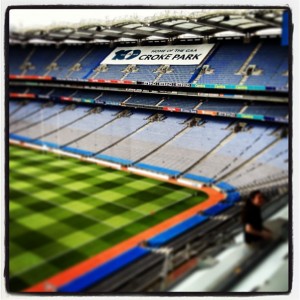Stadiums are interesting places, even for those who do not actively watch or follow the sports that take place in them. As I take a seat in Croke Park’s section usually meant for announcers and sportcasters, I soon realize that this particular stadium stands out a bit more from the others I’ve visited. Earlier today, our guide had explained the Irish way of support for teams, the way that they stick to their home county, no matter where they are in the country (or the world). It’s a bit strange to the average American way, where one can ‘adopt’ teams of other cities in case of a displacement.
Sitting back in the semi-comfortable plastic seat, my focus switches back to the tour guide who’s been leading us through the stadium. The park itself has been around since the 1880s, and was a prominent part of the GAA from its inception in 1884. The park ran into financial problems in 1908, and a GAA member by the name of Frank Dineen purchased Croke Park for the sum of $3,250. The GAA managed to pool together the resources necessary to purchase the park from Dineen, and in 1913 Croke Park was signed over for $3,500.
Our guide gestures to one of the the four sides of the stadium, smaller in height than the others. She says the name of that section is Hill 16, and was once nothing but a mound of dirt and grass that spectators crowded onto. Once known as Hill 60, referencing a brutal and bloody fight in Gallipoli in WW1, its current name comes from the Easter Rising of 1916 – the rubble produced from the destruction of Dublin buildings by the British gunboat Helga was used to create a more permanent fixture on the hill. The hill as it stands today is the gathering ground of Dubliners, the section turning into a sea of sky blue during games when Dublin’s team is playing.
We are led out of the stands, back through the Broadcaster’s box, and go down a level where we come to a black stone monument – the stadium’s remembrance to the events of Bloody Sunday. One cannot speak of Croke Park without mentioning the events of that day – the stadium was the site where a force of RIC police and the British Auxiliary Division opened fired on the crowd in the stands after a group of British Intelligence officers were assassinated by Michael Collins and his men earlier in the day. It is still hotly debated whether or not they were provoked by IRA agents, or if they opened fire on their own.
In the aftermath, 13 spectators and the captain of Tipperary’s team, Michael Hogan, had been killed. It was to them that the monument was built, and one of the sections was named after Hogan himself. It’s a sobering lesson in the blood-stained history of Ireland.

